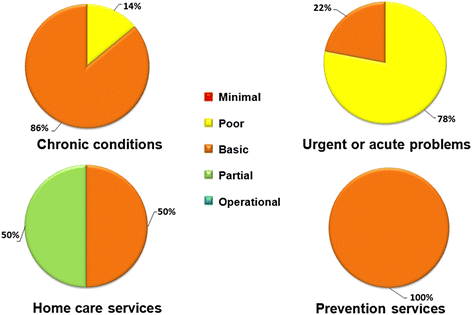Operational integration in primary health care: patient encounters and workflows
- PMID: 29187189
- PMCID: PMC5706391
- DOI: 10.1186/s12913-017-2702-5
Operational integration in primary health care: patient encounters and workflows
Abstract
Background: Despite several countrywide attempts to strengthen and standardise the primary healthcare (PHC) system, Greece is still lacking a sustainable, policy-based model of integrated services. The aim of our study was to identify operational integration levels through existing patient care pathways and to recommend an alternative PHC model for optimum integration.
Methods: The study was part of a large state-funded project, which included 22 randomly selected PHC units located across two health regions of Greece. Dimensions of operational integration in PHC were selected based on the work of Kringos and colleagues. A five-point Likert-type scale, coupled with an algorithm, was used to capture and transform theoretical framework features into measurable attributes. PHC services were grouped under the main categories of chronic care, urgent/acute care, preventive care, and home care. A web-based platform was used to assess patient pathways, evaluate integration levels and propose improvement actions. Analysis relied on a comparison of actual pathways versus optimal, the latter ones having been identified through literature review.
Results: Overall integration varied among units. The majority (57%) of units corresponded to a basic level. Integration by type of PHC service ranged as follows: basic (86%) or poor (14%) for chronic care units, poor (78%) or basic (22%) for urgent/acute care units, basic (50%) for preventive care units, and partial or basic (50%) for home care units. The actual pathways across all four categories of PHC services differed from those captured in the optimum integration model. Certain similarities were observed in the operational flows between chronic care management and urgent/acute care management. Such similarities were present at the highest level of abstraction, but also in common steps along the operational flows.
Conclusions: Existing patient care pathways were mapped and analysed, and recommendations for an optimum integration PHC model were made. The developed web platform, based on a strong theoretical framework, can serve as a robust integration evaluation tool. This could be a first step towards restructuring and improving PHC services within a financially restrained environment.
Keywords: Clinical pathways; Greece; Integrated care; Operational integration; Outcome; Primary health care; Process assessment (healthcare); Quality indicators (healthcare); Structure.
Conflict of interest statement
Authors’ information
DSP, MPH, PhD(c), Epidemiology and Public Health Researcher in the Clinic of Social and Family Medicine, School of Medicine, University of Crete.
VEC, MPH, Welfare Management, Health Researcher in the Clinic of Social and Family Medicine, School of Medicine, University of Crete KK, PhD, Researcher in the Information Systems Laboratory (ISL), Institute of Computer Science (ICS) at the Foundation for Research and Technology, Hellas (FORTH).
AM, APRN-BC, PhD, Associate Professor, University of Alabama at Birmingham.
EP, Public Health Specialist, MPH, FRSPH, DrPHc, Senior Research Fellow, Clinic of Social and Family Medicine, School of Medicine, University of Crete.
CL, MD, PhD, FRCGP (Hon) Professor of General Practice and Primary Health Care,
Clinic of Social and Family Medicine, School of Medicine, University of Crete.
Ethics approval and consent to participate
Ethics approval was obtained from the Health Region of Crete (Ref. #9674), the Health Region of Piraeus and Aegean (Ref. #38865) and the Ministry of Health and Solidarity (Ref. #38865). In addition, written consent was obtained from all participants, HCPs and patients, prior to the survey, following full disclosure about the study. No sensitive and personal data were recorded, while confidentiality of data was assured during data analysis and reporting. Data were saved in password protected electronic files, accessible by select members of the research team.
Consent for publication
Not applicable.
Competing interests
The authors declare that they have no competing interests.
Publisher’s Note
Springer Nature remains neutral with regard to jurisdictional claims in published maps and institutional affiliations.
Figures
References
-
- World Health Organization . Geneva. 2008. Integrated health services - what and why? Technical brief no. 1.
-
- Glasby J, Dickinson H. Partnership working in health and social care: what is integrated care and how can we deliver it? Bristol: Policy Press; 2014.
-
- Nolte E, McKee M. Integration and chronic care: a review. In: Nolte E, McKee M, editors. Caring for people with chronic conditions. Geneva: Open University Press; 2008.
-
- Kruis AL, Boland MR, Assendelft WJ, Gussekloo J, Tsiachristas A, Stijnen T, Blom C, Sont JK, Rutten-van Mölken MPHM, Chavannes NH. Effectiveness of integrated disease management for primary care chronic obstructive pulmonary disease patients: results of cluster randomised trial. BMJ. 2014;349:g5392. doi: 10.1136/bmj.g5392. - DOI - PMC - PubMed
MeSH terms
Grants and funding
LinkOut - more resources
Full Text Sources
Other Literature Sources
Medical



